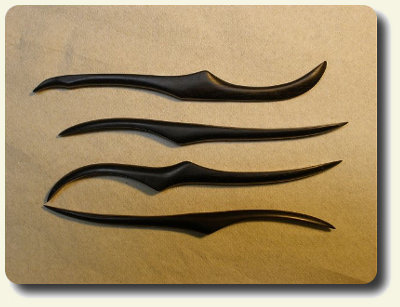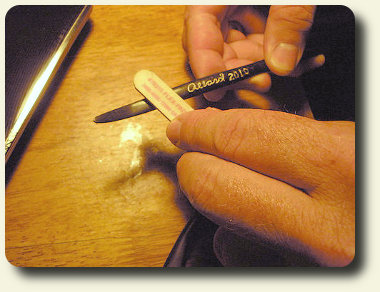
 CDHM The Miniature Way
CDHM The Miniature Way
September 2010, Issue 8
Tools
Page 21

I also recommend that you do some drawings of the shape of your tool ahead of time so you have some reference to work from. This is the cool part because you can make some really original designs or you can just make
 something that really does the trick to smooth out the face, or poke that right-size square shape, or push that small amount of clay up around the eyes, etc…
something that really does the trick to smooth out the face, or poke that right-size square shape, or push that small amount of clay up around the eyes, etc…
As you can see in the pictures of my tool designs you can even make traditional shapes that just have cool handles or whatever, the sky is the limit. Next we need some wood, so what is a good wood for making tools? Any fine grained wood and most of those fall into the exotic category: Canary wood, Boxwood, Rose wood, Maple and Olive wood are just some types.
 I suggest looking online and check out the types of fine grain hardwoods both exotic and local. Look at their colors and patterns and then pick one that appeals to you. Most woods can be purchased in small quantities or as pen blanks, many places online sell wood, ebay has a ton of woods for sale and lots of exotics. My favorite personally and what I have started to make all of my tools from is Ebony wood. Ebony wood is super-hard, super-fine grained and sands, then polishes, to a glass-like finish.
I suggest looking online and check out the types of fine grain hardwoods both exotic and local. Look at their colors and patterns and then pick one that appeals to you. Most woods can be purchased in small quantities or as pen blanks, many places online sell wood, ebay has a ton of woods for sale and lots of exotics. My favorite personally and what I have started to make all of my tools from is Ebony wood. Ebony wood is super-hard, super-fine grained and sands, then polishes, to a glass-like finish.
A similar wood that I am also playing with is Briar, the kind they make pipes from. As an FYI both of these woods are pricey, but I feel it is a small trade-off for the results I get, that and you really don't need to buy it in any sort of huge quantities unless you are going into production.
I start by taking an appropriately sized piece and then drawing my design on it with a white grease pencil (crayon, marker, whatever works) so you can clearly see your design on the wood. Use markers on light wood as a last resort because the ink can soak in and then be a problem to sand out later.
Custom Dolls, Houses & Miniatures / CDHM







